We are officially at the halfway point of the Indiana basketball season. Fifteen games are down, and 15 are on the horizon as Mike Woodson continues his first season back at his alma mater.
IU stands at 12-3, with a 3-2 record in the Big Ten, and a respectable 23rd position in the KenPom rankings as of Jan. 11. We have a decent sample size now to assess what we’ve seen from Indiana on the basketball court, and on the stat sheet.
Let’s look at some takeaways from the first half of the season, and what it means as we tip towards the back end of the schedule.
Overall Takeaways
This is written before I take a deep dive into the stats, and is purely based on what I’ve seen with my eyes. The overall takeaways for me are largely positive.
Considering what was predicted before the season, 12-3 is a good record, and it is even better if you are of the opinion that Indiana is the only reason the Hoosiers aren’t unbeaten (spoiler: I am).
The first loss against Syracuse featured a staggering 26 turnovers, and to put up 110 points in the double-overtime loss in spite of that was staggering as well.
The second loss to Wisconsin featured an all-time capitulation down the stretch, with Indiana losing its composure and falling late after leading by over 20 at one point.
The third loss was a case of Indiana failing to show up on the road against a mediocre Penn State team. This may be a stretch to say this is Indiana beating itself, as Penn State did well to hit its shots and mitigate what the Hoosiers are good at.
Overall, progress has been apparent since day one from where it was left under Archie Miller, and it has continued into the halfway point.
Rob Phinisee’s improvement over the season has coincided with Indiana cleaning up the turnovers, Race Thompson has continued his evolution into an all-around forward, and Indiana finds itself with one of the best defensive units in the country.
Now, these are all opinions. Let’s look at some stats, and some cold-hard facts.
The Four Quadrants of the Big Ten
Indiana finds itself in an interesting spot through 15 games. KenPom rates IU's adjusted defensive efficiency (points allowed per 100 possessions) at 90.4, good for 11th in the country as of Jan. 11.
Offensively, the story is different. An adjusted offensive efficiency rating of 109.3 is just 70th in the country, letting the Hoosiers down in a few games, and keeping them from the top end of the rankings and the Big Ten.
Here is how Big Ten teams compare to one another in terms of their efficiencies on both ends of the court:
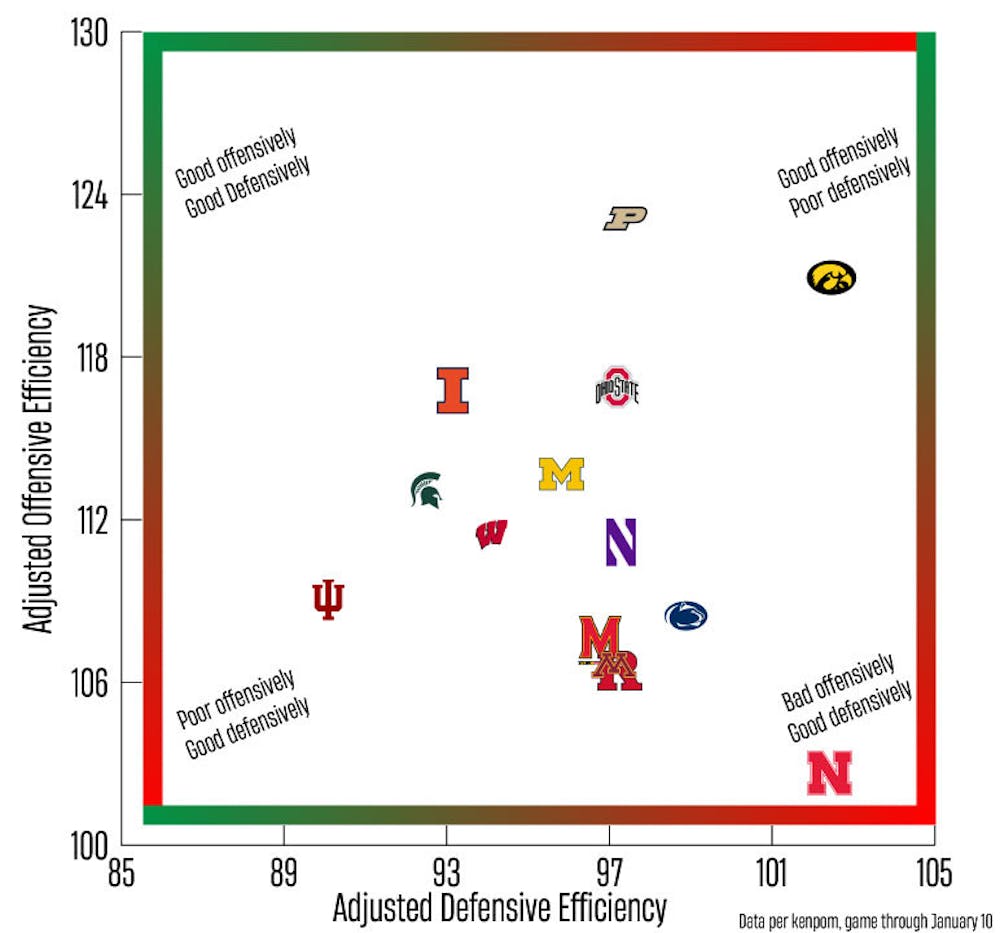
Indiana sits in the bottom left quadrant of the chart, with the best defense in the Big Ten, but a distinctly average offense. If Indiana can push its offensive performances up ever so slightly, IU can push its numbers closer to those of Michigan State (10th in the latest AP Poll) Wisconsin (13th) or Illinois (25th).
At the moment, Indiana finds itself in an interesting position, with a great defense to fall back on, but lackluster offense holding the team back.
Side note before takeaway two: Iowa is the polar opposite of Indiana. That should make for fun viewing on Thursday’s contest. Read more on that here, from our very own Zion Brown.
Trayce Jackson-Davis and Co.
Breaking news: the stats say that Trayce Jackson-Davis is good at the sport.
Jackson-Davis is fifth in the Big Ten in scoring (19.4 PPG), fifth in rebounding (8.7 RPG), third in blocking (3.0 BPG), and 10th in shooting (60 percent). This graph may not stun anybody, but it is representative of Jackson-Davis' dominance.
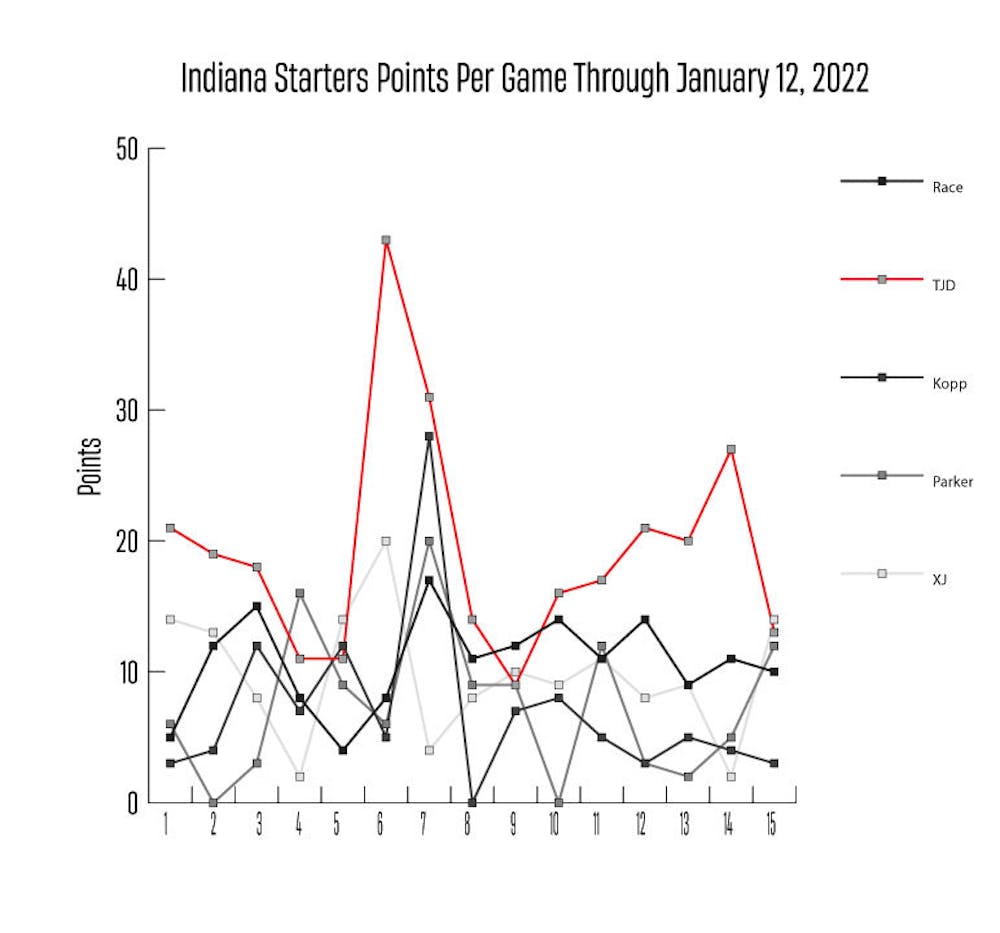
Only one time has the starting lineup combination been broken (Parker Stewart didn’t start against Northern Kentucky), yet there have been some very low point performances. Stewart and Miller Kopp especially have had some very lackluster performances, highlighting their hot and cold nature.
The ninth game was against Wisconsin, which held Jackson-Davis to a season-low nine points. Indiana had a good defensive display, holding the Badgers to 64 points, yet lost the game because Indiana’s key piece was nullified.
Let’s narrow it down to one player in particular: Miller Kopp.
What happened to Kopp?
Miller Kopp had a season-high 28 points against Syracuse. He came close to carrying Indiana to victory at the Carrier Dome, and even in defeat, it felt like his breakout moment in an IU jersey.
He followed the season-high with a season-low zero points against Nebraska in 24 minutes of play. Here are his points per game over the 15 games this season:
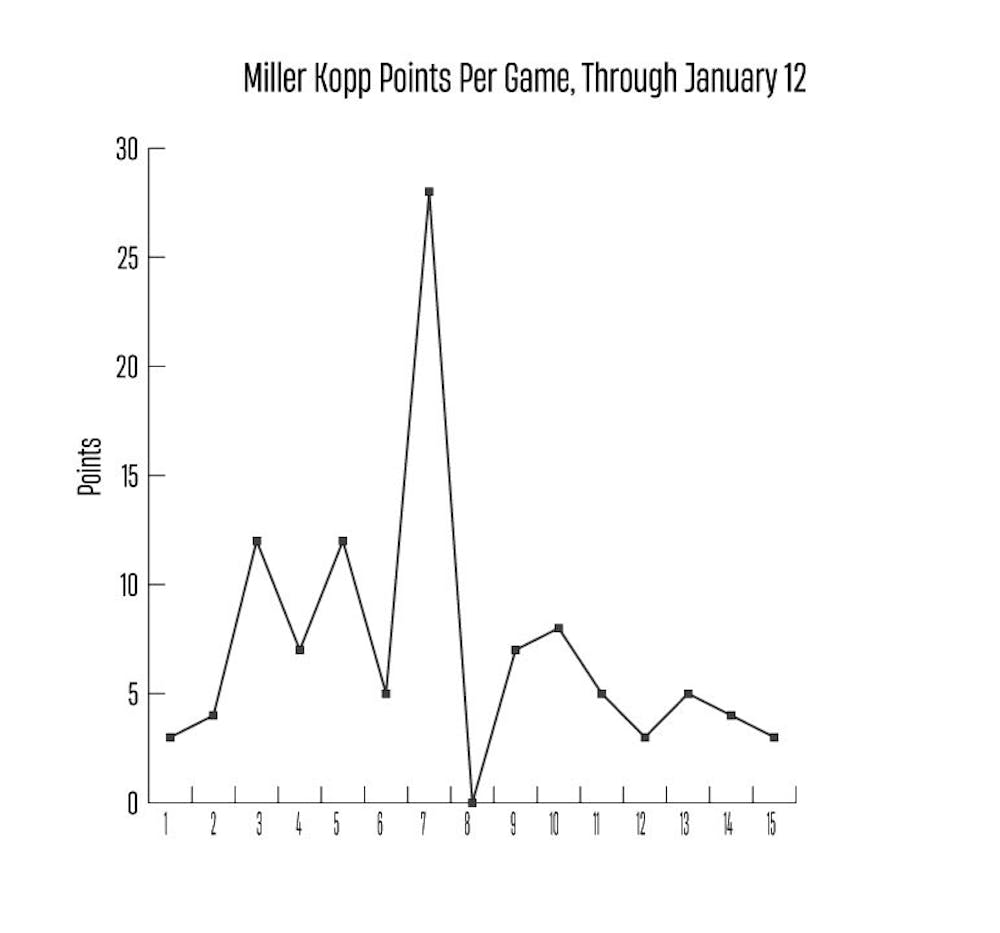
The graph above shows two stories on opposite sides of the Syracuse performance. Let’s break the numbers down in better depth.
| Minutes/Game | Points/Game | FGA/Game | Field Goal% | |
| Pre-Syracuse | 23 | 7.2 | 6 | 36% |
| Post-Syracuse | 24.8 | 4.4 | 5.1 | 34% |
His minutes have gone up, but the underlying numbers have gotten worse. Not pretty viewing for Woodson from one of the starters.
Kopp is clearly going through a slump. Very understandable, considering players are humans, and he is still in his first season under a new head coach. We’ve seen players come in and out of importance during the season, and there is no reason a starter is immune to that.
Is Kopp a bad player? Not in the slightest, we’ve seen his talent during his 28-point, four-rebound, three-assist, and two-steal performance against Syracuse, on 9-for-16 shooting. Should he be a guaranteed starter? That’s a different discussion entirely.
The optimistic takeaway from Kopp struggling is that in the eight games since Syracuse, Indiana is 6-2 even with a below-average starter. If Kopp can return to that average, or even surpass it, Indiana becomes a better team for it.
Indiana needs its offense to be just average to win games
What has been the team's worst offensive performance this season?
Looking at the simple field-goal percentage, the five worst field-goal percentages in individual games are as follows:
- @ Wisconsin, 38.71%, 59-64 loss
- @ Penn State, 39.7%, 58-61 loss
- vs. Nebraska, 40.4%, 68-55 win
- vs. Ohio State, 41.0%, 67-51 win
- vs. Eastern Michigan, 41.9%, 68-62 win
Four of the five Big Ten games and the season opener. It is not revolutionary thinking to say that odds of winning are reduced with inferior shooting, but Indiana managed to win three of these games, and had narrow losses on the road to Big Ten teams in the two sub-40 percent games.
When contrasted with what IU allowed for its opponents, Indiana’s below-average offense is rarely worse than the numbers its opponents put up:
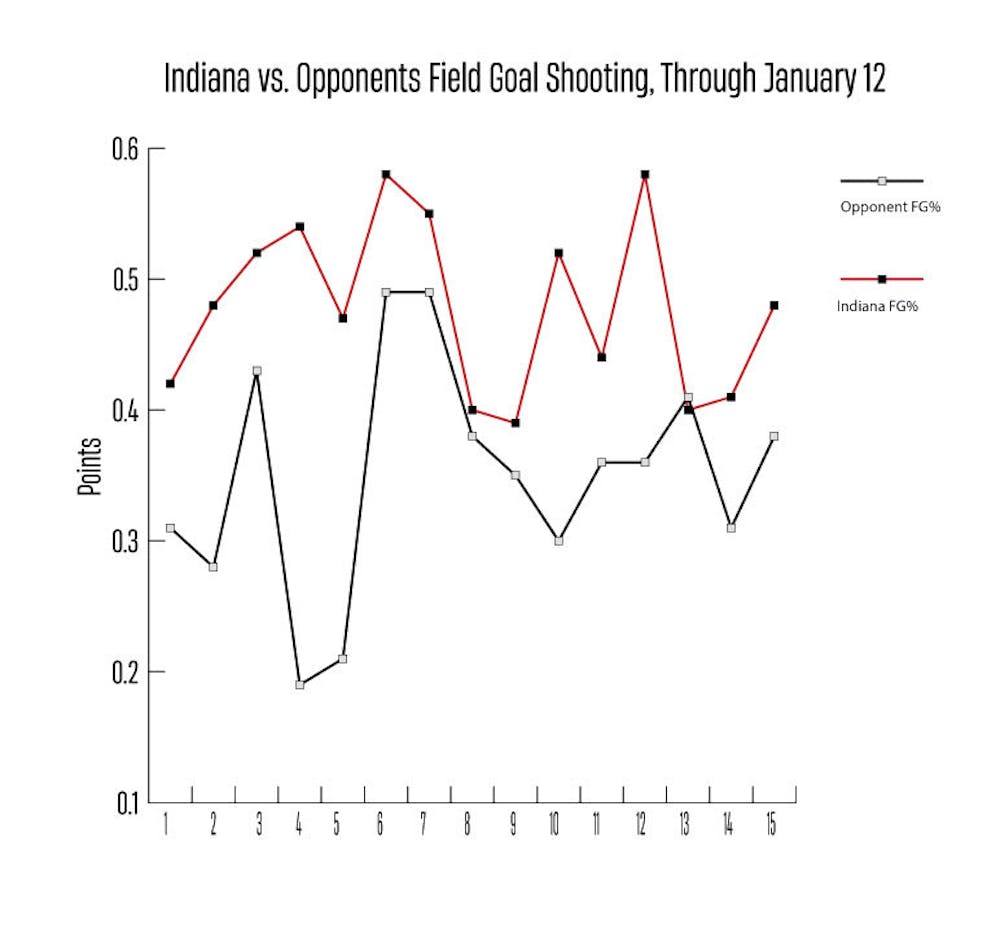
There was just one game where an opponent had a better field-goal percentage than Indiana: the ninth game of the year, against Penn State on Jan. 2, and it was under a 2 percent difference.
The Hoosiers can rely on their defense to keep them in games, even when their offense isn’t at the standard. When Indiana surpass its average shooting percentage of 47.8 percent, the team is 6-1, with the lone defeat the turnover-filled Syracuse trip.
This is a two-part takeaway: Indiana’s offense has been just enough, and its defense has been great. If the offense can make improvements, this team is going to be hard to beat.
The entire point guard group
This section found itself getting too big and too complicated to be one part of five in an article. Needless to say, Indiana’s point guard room has been a subject of much discussion this season.
William McDermott wrote about the debate earlier this season, and not much certainty has changed since.
Xavier Johnson is the clear starter, while Phinisee has been the clear sixth man. Khristian Lander’s role has been impossible to define, with many zero-minute games populating his stat sheet.
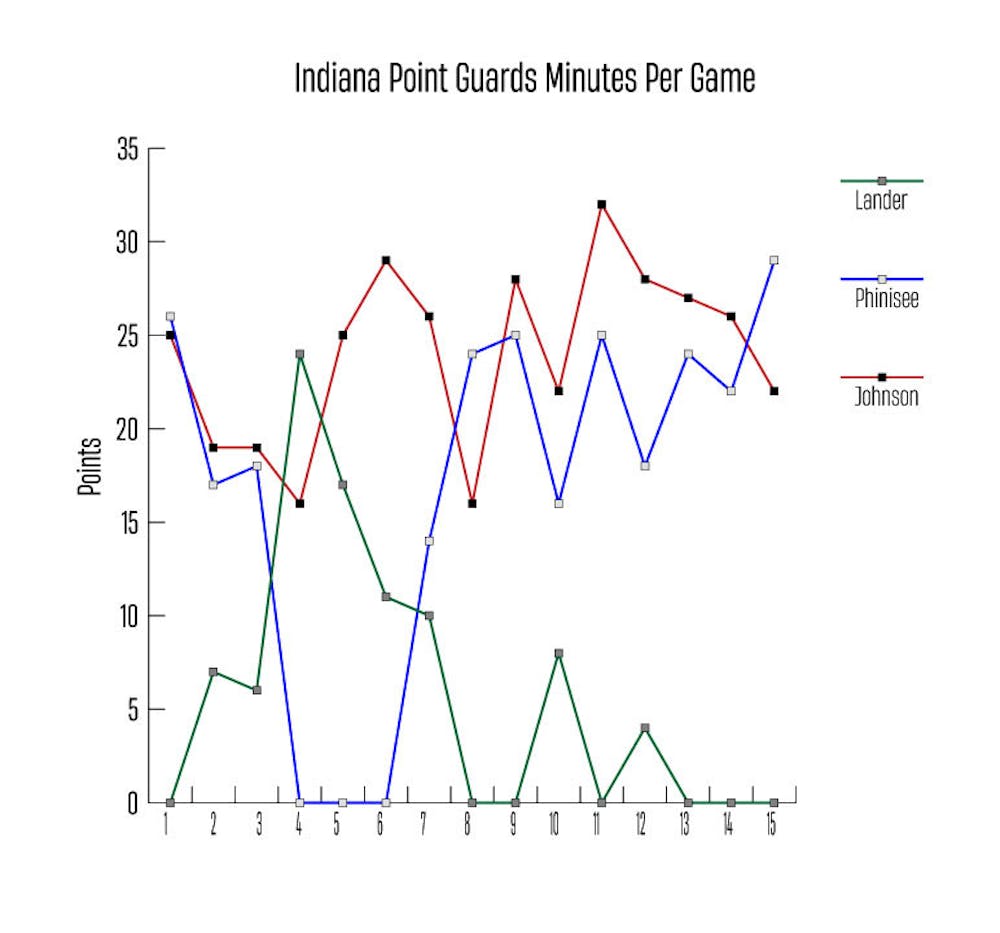
A sore leg kept him out of the Minnesota game, but it’s clear that Woodson doesn’t have full faith in his role in running the offense.
Indiana needs both Johnson and Phinisee operating with high availability, considering the hot and cold play of both guards, Woodson can hang his hat on trying to time their appearances right to capitalize on the entire strengths of his guard group.
Competition for that spot can breed success, and this takeaway is mainly that the group is still both undefined and not fully tapped into.
Overall takeaways
Indiana is a good basketball team with an average offense. The potential of the team is high, with the defense still having room to grow beyond its current top-10 standards, and an offense with much room to grow whether that be current starters, or players ready to make a step into more minutes.
The last half of the season will pose many challenges for Woodson and his squad. Can they keep up with the Big Ten gauntlet? What happens when Jackson-Davis is stifled? Can IU become a consistently good offensive team? Can the Hoosiers beat Purdue?
Many questions remain, and there is just half a season left to answer them.





